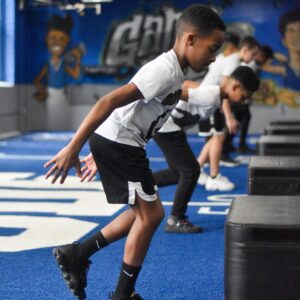August 1st is a holy day: part reunion, communion, and boot camp. The sun, peering from the sky. Waiting. Witnessing. Arms folded watching our boys march onto the barren fields, lined with bleachers and baby sisters. August 1st – the start of youth football season. I remember my son’s first summer. Sending him to the field was like seeing him off to college. His cleats, tied tightly against his chocolate skin. Helmet snug against his head. Behind the pads, this lengthy boy put down his video games to become an athlete.
I have the privilege of hovering between worlds. By day, I spend my time convincing people that the skills youth develop by practicing art extend far past what can be seen on a canvas. As a former football volunteer for the West Elmwood Intruders, I learned that sports can be just as transformative. Over the years, I’ve met many people who are responsible for this transformation. Pamela Huges, former president of the Mount Hope Cowboys, ran track for Hope Highschool and still holds multiple high school and college records, including a 38-year RI High School Girls Outdoor Long Jump Record. For her, running track was more than running fast. Track created opportunities for her to travel and compete. Pam understands that she and her Mount Hope staff create more than football teams: They create community.

Nadim Robinson is one of those staff members. As a Cowboys coach and founding director of Behind The Pads – Nadim views coaching as a way to practice his most sacred values. As a member of the Nation of Gods and Earths, “One of our main duties is to teach the babies,” says Nadim. “Everyone has their form of protest; an individual’s idea of how to change the world.” Changing the world starts with our youth. Behind the Pads is a youth travel league that elevates the value of discipline, structure, and teamwork – “If you’re signing up to play football, you’re signing up to block and tackle.” Nadim’s sentiment demonstrates the way football teaches youth to be accountable to themselves and others.

It’s also about the joy, which is so connected to not only our kids’ mental health but their life force. 10-year veteran coach Zayquan “Ziggy” Gadson of the West Elmwood Intruders gets it: “My favorite part of the job are the smiles we create. Those moments when a kid scores, makes a tackle or catch. Win or lose, the feeling lasts a lifetime.” Youth sports undoubtedly cultivate life skills. So why are youth sports organizations (YSO) so under-resourced? YSOs are independent of school system support; they’re lone non-profits. They have three streams of income – registration fees, sponsorships, and grassroots fundraisings. Staff are unpaid volunteers. There are very few grant opportunities, which is different from youth arts programs, whose operations are largely grant-funded. As workers, we are paid. On the other hand, YSO’s operational expenses are at the whim of a team’s ability to hustle, which often means passing the can at busy intersections. Lorenzo Perry – Cowboys coach and founding director of Game Day Fitness, a training arena for youth athletes, says lack of funding was the reason for diversifying how he approaches his work. “There was never any money. I eventually decided to start my own gym with a privately funded model.” Lorenzo believes his kids deserve more. Waiting for funding is not an option.
Working within the arts, I’ve come to understand:
- People fund what they know about. Lack of public visibility impacts advocacy efforts. Pam recalls news outlets affirming that they “don’t cover youth sports,” but as soon as a far-from-flattering situation occurs, the cameras show up. “Where are they,” she asks, “when our kids go to Nationals?”
- People fund what they care about. Does a country obsessed with competition really not care about youth sports? Or do they not care about the people playing them? Demographically, art organizations are heavily non-Black and attract families that come from more affluent backgrounds. However, the football field is filled with African Americans who have grown up in PVD and are underrepresented in formal leadership roles within our community. Does the difference in racial makeup explain the difference in care/funding?
- People fund what other people fund. People are followers. We know this… but so are philanthropists. The more funding an organization has is often tied to how much more they can get. Maybe it’s the law of attraction? What does it mean when an organization has 0 dollars? Does zero keep attracting zeros? Lack of existing grant opportunities makes it harder to attract future funding, creating a perpetual cycle of little-tono support.
The bottom line is youth sports organizations, especially inner-city youth football, deserve our attention and investment.
This is not about pitting arts against sports. We should be investing in both. As both teaching artists and coaches, we know our work is much deeper than creating rock-star athletes and celebrity artists; it’s about supporting youth in becoming the best versions of themselves – a self that has the capacity to hold the challenges and beauty of life ahead. Let’s fund our youth, period. Our kids deserve it.
Contacts: Lorenzo Perry, @gamedayfitness; Pamela Hughes, fb.com/pamela.hughes.100; Nadim Robinson, @behindthepads_btp